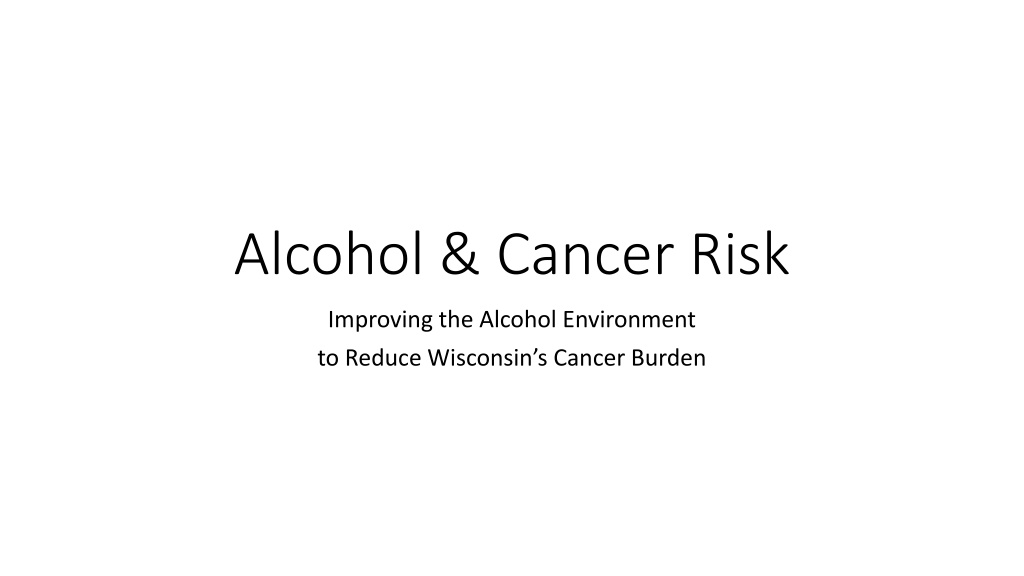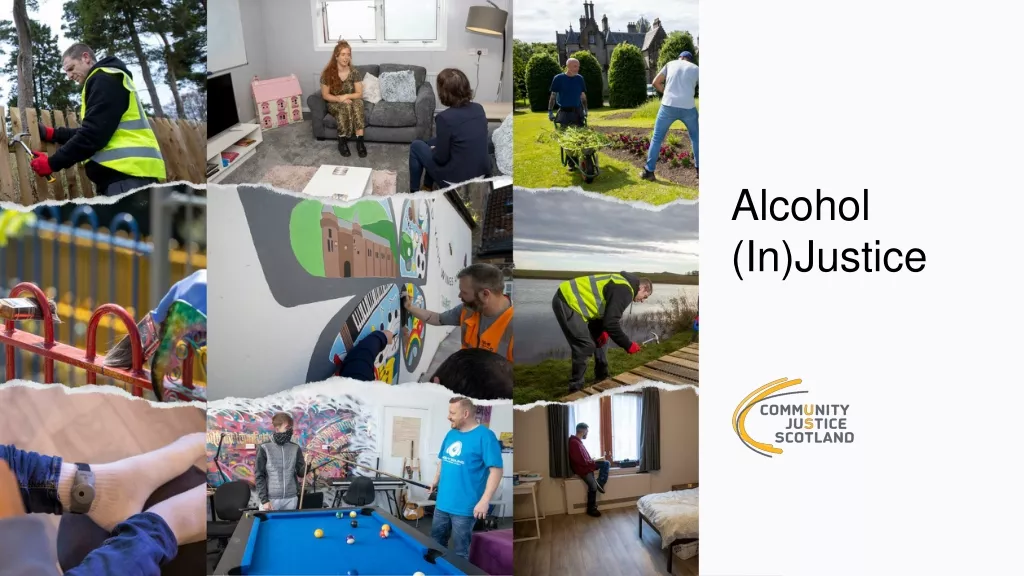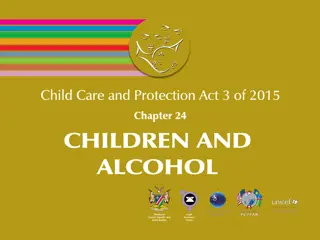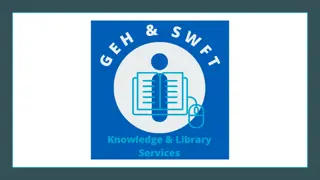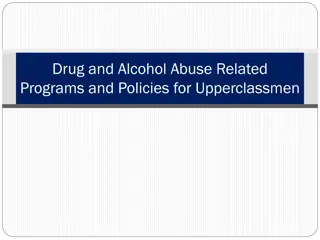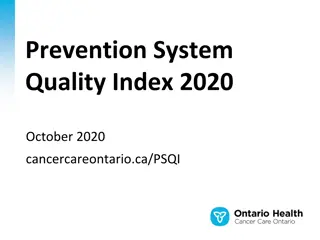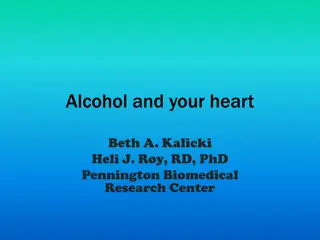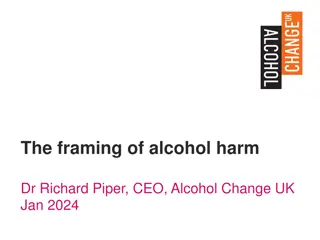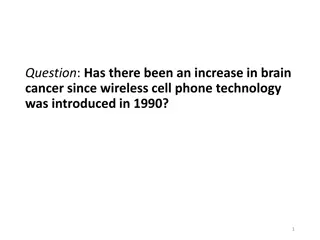Alcohol and Cancer Risk: Understanding the Links
Alcohol consumption is linked to an increased risk of various cancers, including mouth, throat, esophagus, breast, liver, and colorectal cancers. Factors such as ethanol, acetaldehyde, nutrient absorption, estrogen levels, and liver cirrhosis play a role in this risk. Even light drinking can elevate cancer risk, and heavy or high-risk drinking intensifies this further. Alcohol use is a significant risk factor for cancer deaths in the U.S., stressing the importance of addressing alcohol-related cancer burden, particularly in states like Wisconsin. Awareness of high-risk drinking patterns and their associated cancer risks is crucial in cancer prevention efforts.
Download Presentation

Please find below an Image/Link to download the presentation.
The content on the website is provided AS IS for your information and personal use only. It may not be sold, licensed, or shared on other websites without obtaining consent from the author.If you encounter any issues during the download, it is possible that the publisher has removed the file from their server.
You are allowed to download the files provided on this website for personal or commercial use, subject to the condition that they are used lawfully. All files are the property of their respective owners.
The content on the website is provided AS IS for your information and personal use only. It may not be sold, licensed, or shared on other websites without obtaining consent from the author.
E N D
Presentation Transcript
Alcohol & Cancer Risk Improving the Alcohol Environment to Reduce Wisconsin s Cancer Burden
Alcohol and Cancer Alcohol and Cancer Alcohol use increases the risk of at least 7 different cancers: Mouth & Throat Larynx Esophagus Breast Liver Colorectal Image: https://wicancer.org/wp-content/uploads/InfoGraphic_Alcohol_Final.pdf Source: International Agency on Research on Cancer. IARC Monograph. Volume 96. 2010.
How does alcohol increase cancer risk? Many potential pathways, including: Ethanol > Acetaldehyde Blocking absorption of nutrients like folate Increasing estrogen levels Cirrhosis of the liver The International Agency on Research on Cancer classifies alcohol as a known human carcinogen and has since the late 80s. Sources: National Cancer Insitute. Alcohol and Cancer; International Agency on Research on Cancer. IARC Monograph. Volume 96. 2010
How much is too much? Even light drinking can increase your cancer risk for some cancers, including breast. But, drinking heavily, especially over a longer period of time, has the greatest impact on risk. Especially for head and neck cancers. Image: https://wicancer.org/wp-content/uploads/InfoGraphic_Alcohol_Final.pdf Source: LoConte N, et al, Journal of Clinical Oncology 36, no. 1,83-93.
So, what is high risk? High-risk drinking includes: Heavy drinking 8+ per week for women, 15+ per week for men Binge drinking 4+ on one occasion for women, 5+ on one occasion for men Underage drinking Image: https://wicancer.org/wp-content/uploads/Alcohol-and-Cancer-FAQ_design_FINAL.pdf Source: Centers for Disease Control and Prevention
Why is alcohol use an important risk factor? Approximately 3.5% of all cancer deaths in the U.S. (~20,000 deaths per year) are attributed to alcohol use. Alcohol use is a common avoidable risk factor, especially in Wisconsin! 68% drink alcohol 17% smoke cigarettes 19% no physical activity 24% veggies <1x/day Sources: Nelson et al, Am J Public Health. 2013; 103(4): 641-648; Parkin DM et al, Br J Cancer. 2011;105:S77-81; Centers for Disease Control and Prevention. BRFSS. 2015/2016.
Burden of alcohol-related cancers in Wisconsin Cancer Type Mouth & Throat Larynx Esophagus Breast Liver Colorectal Average Annual Cases 790* 234* 352* 4,312 428 2,570 Average Annual Deaths 164* 55 321* 767 355 950 * Rate is above the national average Find County-level data here: https://tinyurl.com/WICountyCancer Source: American Cancer Society. Facts and Figures: Cancer in Wisconsin. 2016.
Why should we discuss alcohol and cancer? Awareness of the connection is low. Only 30% of adults in US know that alcohol is a cancer risk factor Compared to 78% for tobacco and 66% for sun exposure Until recently, many cancer organizations were not discussing. Increased awareness of the connection is shown to: Encourage behavior change. Increase support for policies that prevent and reduce excessive drinking. Sources: ASCO National Cancer Opinion Survey 2017; Hawkins et al., Health Educ Behav. 2010; 37(4): 490-503; Buykx et al., BMC Public Health, 2018, 18(688).
American Society of Clinical Oncology (ASCO) Alcohol and Cancer Statement ASCO statement in November 2017 discussed: Evidence of alcohol and cancer link Areas of needed research Public health strategies to reduce excessive drinking Role of the oncologist in addressing this issue
Meta-analysis of alcohol use and cancer risk 2-4 4+ 0-1 drink/d drinks/d drinks/d Source: LoConte N, et al, Journal of Clinical Oncology 36, no. 1,83-93.
Strategies endorsed by ASCO in statement Support clinical strategies to reduce high-risk alcohol consumption. Regulate alcohol outlet density. Increase alcohol taxes and prices. Maintain limits on days and hours of sale. Enhance enforcement of laws prohibiting sales to those under 21. Restrict youth exposure to advertising of alcoholic beverages. Resist further privatization of retail alcohol sales. Include alcohol strategies in state Comprehensive Cancer Control Plans. Support efforts to eliminate pinkwashing. Source: LoConte N, et al, Journal of Clinical Oncology 36, no. 1,83-93.
ASCO: Role of the oncologist Assist patients in reducing their high-risk alcohol use Identify most effective strategies to intervene, especially among cancer patients and survivors Support alcohol-related research, including impact of alcohol use on cancer treatment/treatment outcomes Address disparities in alcohol use/alcohol-related cancers Raise public awareness of the alcohol and cancer connection Support policy efforts to reduce excessive alcohol use Source: LoConte N, et al, Journal of Clinical Oncology 36, no. 1,83-93.
Media attention from ASCO statement New York Times Cancer Doctors Cite Risks of Drinking Alcohol WI State Journal Alcohol Increases Cancer Risk, Says Report Led by UW Doctor Time Drinking A Lot Has Been Linked to Cancer, Doctors Warn Fox News Cutting Back on Alcohol Can Prevent Cancers, Experts Claim Mother Jones Did Drinking Give Me Breast Cancer? NPR (All Things Considered) Drinking Alcohol Can Raise Cancer Risk. How Much Is Too Much?
What is pink-washing? Pink-washing = using the color pink or the pink ribbon to market products associated with breast cancer. Alcohol fundraising by cancer-related organizations: Devalues message Undermines fundraising of others Source: Alcohol Justice, Pinkwashed Drinks: Problems & Dangers
Expert information on alcohol and cancer WI Cancer Council Alcohol Action Plan: https://wicancer.org/action- plans/alcohol-and-cancer/ American Society of Clinical Oncology (ASCO) Alcohol and Cancer Statement: http://ascopubs.org/doi/abs/10.1200/JCO.2017.76.1155 Cancer.net (patient-facing ASCO resources): https://www.cancer.net/navigating-cancer-care/prevention-and-healthy- living/alcohol National Cancer Institute: https://www.cancer.gov/about-cancer/causes- prevention/risk/alcohol/alcohol-fact-sheet American Cancer Society: https://www.cancer.org/cancer/cancer- causes/diet-physical-activity/alcohol-use-and-cancer.html
Policy strategies to reduce excessive drinking Policies shown to reduce excessive drinking are those that affect alcohol Availability i.e. seller licensing Acceptability i.e. norms and perceptions Affordability i.e. prices Attractiveness i.e. marketing Source: WI Alcohol Policy Project, UW Law School
Key messages Alcohol use increases the risk of at least seven different cancers. Even low levels of drinking can increase cancer risk, but the greatest risk if with heavy, long-term use. Policy strategies that are shown to reduce excessive drinking heavy, underage, and binge drinking have the potential to decrease the burden of cancer across Wisconsin. To reduce your cancer risk, drink less. If you do not drink, do not start.
